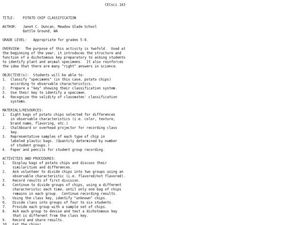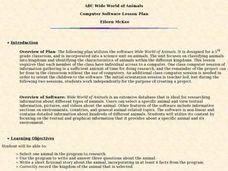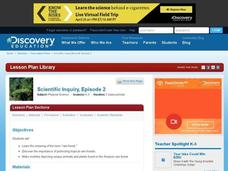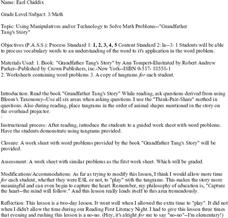Curated OER
Plant and Animal Communities
Second graders discuss the six main classes of animals: insects, birds, fish, mammals, amphibians, and reptiles. They complete a variety of activities about animals. They solve animal riddles, categorize toy animals, create an animal...
Curated OER
Potato Chip Classification
Young scholars classify specimens by observable characteristics. By classifying potato chips, they are introduced to the dichotomous key for identifying plant and animal specimens.
Curated OER
Bison (American Buffalo)
In this science worksheet, students read the facts sheet for the buffalo. They could use this for a class activity for classifying animals.
Curated OER
Fun with Fictitious Animals
How can one differentiate between a dweezlebub and nessie? Use this fictitious creature dichotomous key to find out! Biologists of all ages will enjoy this creative way to learn about classification, including a chance to draw the...
National Nanotechnology Infrastructure Network
Biology Reference Sheet
First year life science or biology pupils will appreciate this all-inclusive reference page. It provides a diagram of both a plant and an animal cell, the metric system prefixes, classification levels, definitions for cell processes, the...
ARKive
Temperate Rainforest in the Pacific Northwest
Explore the amazing temperate rainforest of the Pacific Northwest. Your class starts by investigating the animals and plants of the Northwest, specifically Washington, and then research an animal population common to the area. In small...
Curated OER
Sorting
Students identify how objects can be sorted or classified for easy access. In this sorting activity, students will investigate how letters, numbers, and symbols are used in sorting and classifying.
Curated OER
ABC Wide World of Animals
Fifth graders use the software Wide World of Animals. This lesson is incorporated into a science unit on animals. The unit focuses on classifying animals into kingdoms and identifying the characteristics of animals within the different...
Curated OER
Camouflage
First graders learn how plants and animals adapt to their environments. In this camouflage lesson, 1st graders watch a movie that explains animal camouflage, design a butterfly that blends into a classroom habitat, create a mini book...
Curated OER
The Unique Rain Forest
Students explore the unique Rain Forest. In this Rain Forest instructional activity, students watch a video about the dangers the Rain Forest faces. Students create a Rain Forest mobile. Students choose plants or animals from the...
Curated OER
The Chambered Nautilus
For this chambered nautilus worksheet, learners read a 2 page article, define 10 vocabulary words and answer 7 short answer questions in complete sentences.
Curated OER
Biodiversity in Sixth Grade
Sixth graders explore the nature of habitats on an ABC hike. In groups, they collect items that make up habitats including plants, feathers, and leaves among other materials. Students then classify and organize the collected materials...
Curated OER
Dichotomous Chips
Young scholars create a dichotomous key to different varieties of potato chips. In small groups, they observe and record characteristics of the potato chips to use in the key. They switch keys with another group to see if they can...
Curated OER
Grandfather Tang
Third graders read Ann Tompert's book, Grandfather Tang's Story, and complete math word problems based on the story. In this word problems lesson plan, 3rd graders use tangrams in the word problems.















